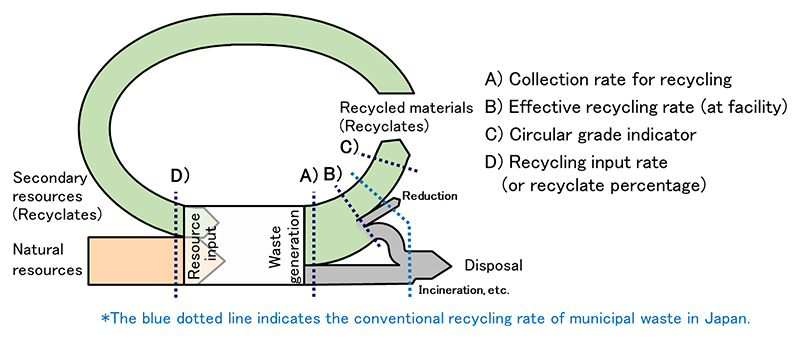NIES-CMW Policy Brief #3
[ Recycling indicators: Limitations of recycling rate in measuring various aspects ]
Published: 23 March 2021
Overview
- Policy theme
- Recycling indicators
- Target audience
- Recycling policy makers, Recyclers, Companies using recycled materials
- The problem
- Limitations of recycling rate in measuring various aspects
- Policy options for resolving the problem
- A set of properly designed indicators to monitor recycling
*1 Sustainable Material Cycle Systems Section, Center for Material Cycles and Waste Management Research
*2 Center for Material Cycles and Waste Management Research

Issues in using recycling rate
Recycling rate, an important indicator to date for monitoring progress in recycling, poses several issues.
- First, recycling rate does not properly evaluate sorted collection of recyclables from the waste to be disposed of. In particular, it does not evaluate source separation by citizens and waste generators.
-
- A gap may be generated between the actual efforts of citizens cooperating in source separation and the calculated recycling rate. For example, even though the citizens sort recyclables, some of them have to be disposed of at recycling facilities due to impurities in materials. As a result, the citizens may feel that their efforts were in vain.
- Second, when a private sector in a municipality collects recyclables, the amount of municipal solid waste (MSW) collected by the municipality decreases. This lowers recycling rate even though actual situation of recycling has not worsened in the municipality.
-
- Private sector's collection includes collection of recyclables (e.g., cans, plastic bottles and white trays) at supermarkets, collection of used paper by newspaper agents, and collection of reusables/recyclables by secondary resource collectors strolling the streets. In recent years, collection by private sectors other than municipalities, especially collection of used paper, has been increasing in Japan.
- Third, recycling rate does not evaluate what percentage of recyclables carried into recycling facilities are effectively recycled (i.e., superiority or inferiority of recycling processes).
-
- In Japan as a whole, about 20% of plastic waste inputs to material recycling facilities remain as residue (Plastic waste that does not meet recyclate criteria remains as residue). Even if plastics are brought into recycling facilities, some are not recycled due to their quality problems.
- Fourth, recycling rate is an indicator to evaluate the amount, not the grade, of recycled materials.
-
- For example, recycling rate does not differentiate between the materials produced by various types of recycling (e.g., upcycling, closed-loop recycling, and cascade recycling).
- Fifth, recycling rate provides no incentive for citizens to use recycled materials.
-
- Even if waste is transformed to recycled materials, they are not necessarily marketable.

Suggested recycling indicators
It is desirable to measure and evaluate the status of recycling by four cross sections as shown in the figure below. After all, we cannot grasp the whole picture only by the use of a single indicator. Even if we use an alternative single indicator, similar issues may arise (e.g., a case of the European Union where using the A-indicator (see the figure) has led to an excess accumulation of low-quality recyclables at recycling facilities and more burden to them).
- Use the A-indicator "collection rate for recycling" to measure the status of sorted collection and prevention of waste outflow to the environment, and to ensure steady recovery of recyclables.
-
- In calculating this indicator for MSW, it is important to make clear about whether or not to include the collection amount by private sectors, and to be careful not to compare the indicators having different definitions.
- Use the B-indicator "effective recycling rate" to measure performance of recycling facilities.
- Use the C-indicator "circular grade indicator" to urge recyclers to conduct higher-quality recycling.
-
- The development of this indicator is a subject for future research. (The authors calculated this indicator on a trial basis and presented the results at the 2019 Conference of the Japan Society of Material Cycles and Waste Management.)
- Use the D-indicator "recycling input rate" to stimulate demand for recyclates and to give due recognition to the efforts of companies using recycled materials and goods.
-
- As the efforts toward circular economy progress, this indicator has been increasingly introduced. It is important to use this indicator (i.e., inflow indicator), in some cases by material category, together with the conventional indicator of recycling rate (i.e., outflow indicator) to monitor the 3R efforts of companies.

Material flows and indicators related to recycling - In addition to the above, it is better to pay attention to regional recycling rate and utilization rate of renewable resources.
- As the efforts toward circular economy progress, this indicator has been increasingly introduced. It is important to use this indicator (i.e., inflow indicator), in some cases by material category, together with the conventional indicator of recycling rate (i.e., outflow indicator) to monitor the 3R efforts of companies.
[Suggested citation]
Tasaki, T., Kawai, K., Terazono, A., Inaba, R. (2021) Recycling indicators: Limitations of recycling rate in measuring various aspects. NIES-CMW Policy Brief #3 (https://www-cycle.nies.go.jp/eng/report/policy_brief_003.html) * The content of this Policy Brief is a proactive interpretation and presentation of policy implications by the authors based on the results of a 2016-2020 research project "Proposal of transition paths and adaptation measures for a circular society." * This Policy Brief is an open access article distributed under the terms and conditions of the Creative Commons Attribution-NonCommercial 4.0 International (CC BY-NC 4.0) license.
Tasaki, T., Kawai, K., Terazono, A., Inaba, R. (2021) Recycling indicators: Limitations of recycling rate in measuring various aspects. NIES-CMW Policy Brief #3 (https://www-cycle.nies.go.jp/eng/report/policy_brief_003.html) * The content of this Policy Brief is a proactive interpretation and presentation of policy implications by the authors based on the results of a 2016-2020 research project "Proposal of transition paths and adaptation measures for a circular society." * This Policy Brief is an open access article distributed under the terms and conditions of the Creative Commons Attribution-NonCommercial 4.0 International (CC BY-NC 4.0) license.



